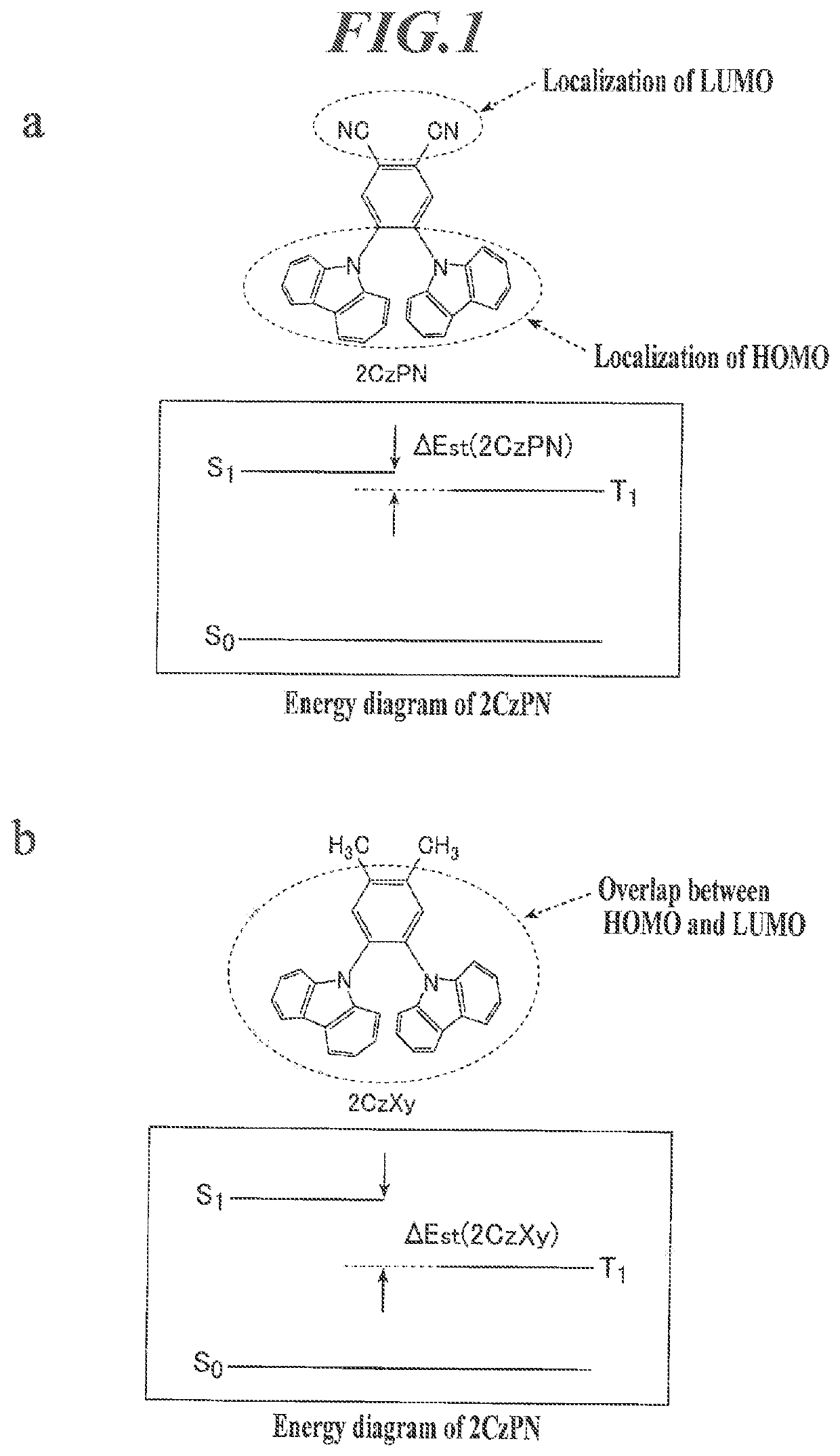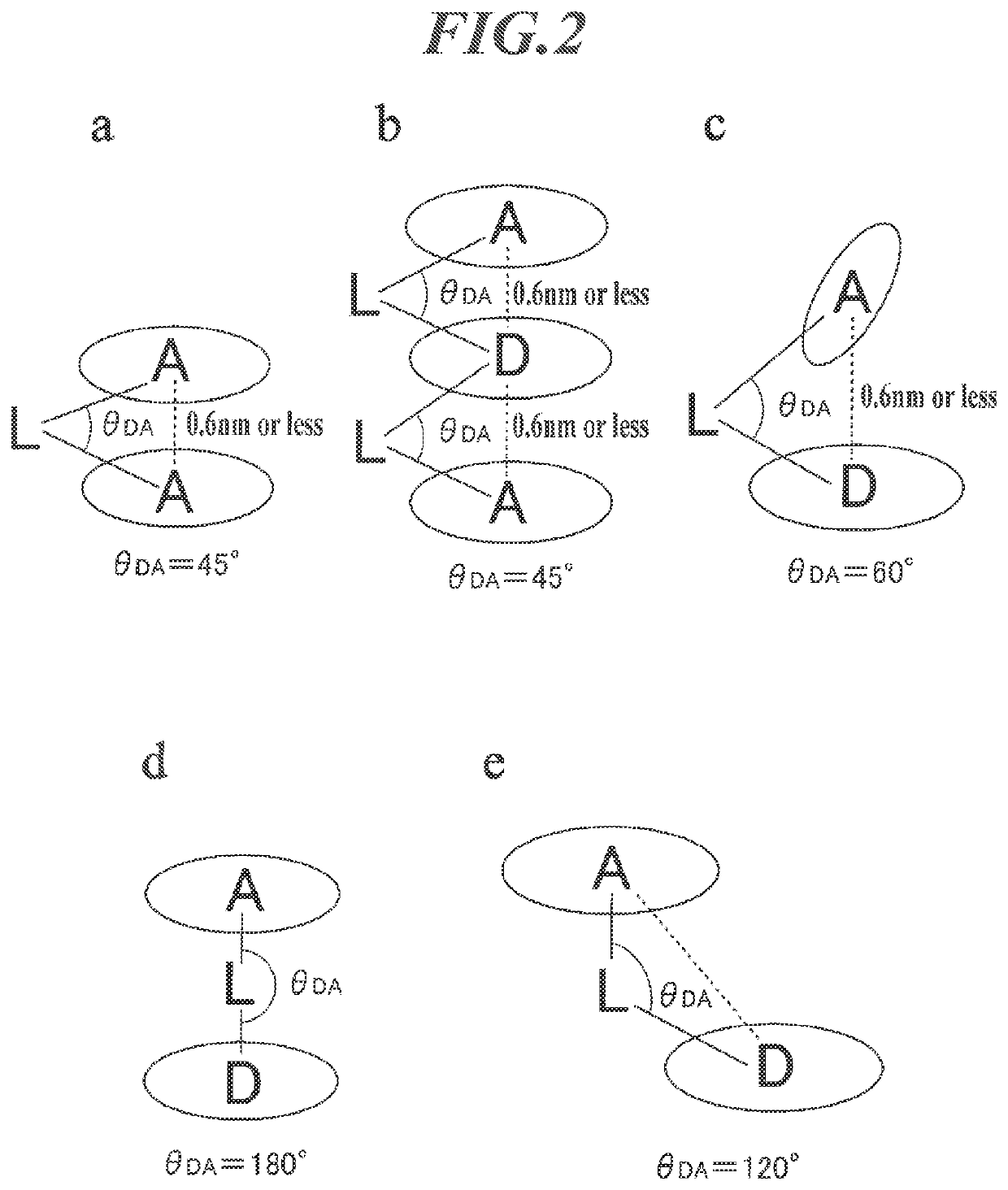Organic electroluminescent device, thin luminous film, display apparatus, and lighting apparatus
a technology of electroluminescent devices and light sources, which is applied in the direction of organic semiconductor devices, organic chemistry, group 5/15 element organic compounds, etc., can solve the problems of compound, unsatisfactory blue light-emitting efficiency or molecular stability, and the inability to use tadf mechanisms in organic el devices. , to achieve the effect of high emission efficiency, low cost and low cos
- Summary
- Abstract
- Description
- Claims
- Application Information
AI Technical Summary
Benefits of technology
Problems solved by technology
Method used
Image
Examples
example 1
(Preparation of Organic EL Device 1-1)
[0527]An indium tin oxide (ITO) anode having a thickness of 150 nm was formed on a glass substrate (50 mm by 50 mm, thickness: 0.7 mm), followed by patterning. The transparent substrate provided with the transparent ITO electrode was ultrasonically cleaned in isopropyl alcohol, dried with dry nitrogen gas, and then subjected to UV ozone cleaning for five minutes. The resultant transparent substrate was fixed to a substrate holder of a commercially available vacuum vapor deposition apparatus.
[0528]Materials for layers were placed in vapor deposition crucibles in the vacuum vapor deposition apparatus in amounts suitable for preparation of an organic EL device. The crucibles were composed of molybdenum or tungsten; i.e., a material for resistance heating.
[0529]The apparatus was evacuated to a vacuum of 1×10−4 Pa, and a vapor deposition crucible containing α-NPD was heated by energization. α-NPD was vapor-deposited onto the ITO transparent electrode...
example 2
[0553](Preparation of Organic EL Device 2-1)
[0554]An indium tin oxide (ITO) anode having a thickness of 150 nm was formed on a glass substrate (50 mm by 50 mm, thickness: 0.7 mm), followed by patterning. The transparent substrate provided with the transparent ITO electrode was ultrasonically cleaned in isopropyl alcohol, dried with dry nitrogen gas, and then subjected to UV ozone cleaning for five minutes. The resultant transparent substrate was fixed to a substrate holder of a commercially available vacuum vapor deposition apparatus.
[0555]Materials for layers were placed in vapor deposition crucibles in the vacuum vapor deposition apparatus in amounts suitable for preparation of an organic EL device. The crucibles were composed of molybdenum or tungsten; i.e., a material for resistance heating.
[0556]The apparatus was evacuated to a vacuum of 1×10−4 Pa, and a vapor deposition crucible containing α-NPD was heated by energization. α-NPD was vapor-deposited onto the ITO transparent ele...
example 3
[0574]Red light-emitting organic EL device 2-10, green light-emitting organic EL device 2-4, and blue light-emitting organic EL device 2-7, which were prepared in Example 2, were arranged on a single substrate, to prepare an active matrix full-color display apparatus illustrated in FIG. 8. FIG. 8 is a schematic illustration of display A of the full-color display apparatus. In detail, the display has, on a single substrate, a wiring unit including a plurality of scanning lines 5 and data lines 6, and a plurality of arranged pixels 3 (red light-emitting, green light-emitting, and blue light-emitting pixels). The scanning lines 5 and data lines 6 of the wiring unit are composed of a conductive material and are orthogonal to each other to form a grid pattern. The scanning lines 5 and the data lines 6 are connected to the pixels 3 at orthogonal intersections (details are not illustrated). The pixels 3 are driven by the active matrix system including the organic EL devices that emit light...
PUM
 Login to View More
Login to View More Abstract
Description
Claims
Application Information
 Login to View More
Login to View More - R&D
- Intellectual Property
- Life Sciences
- Materials
- Tech Scout
- Unparalleled Data Quality
- Higher Quality Content
- 60% Fewer Hallucinations
Browse by: Latest US Patents, China's latest patents, Technical Efficacy Thesaurus, Application Domain, Technology Topic, Popular Technical Reports.
© 2025 PatSnap. All rights reserved.Legal|Privacy policy|Modern Slavery Act Transparency Statement|Sitemap|About US| Contact US: help@patsnap.com



